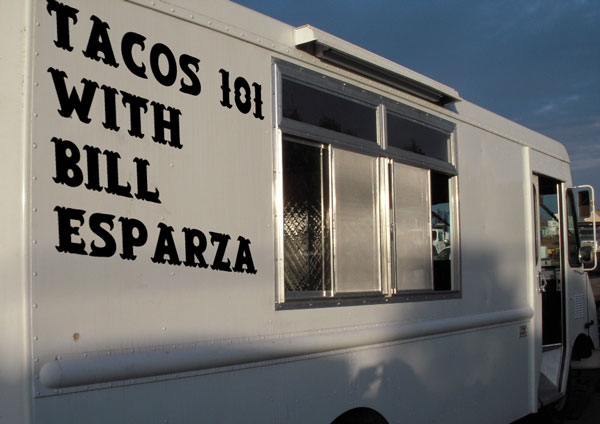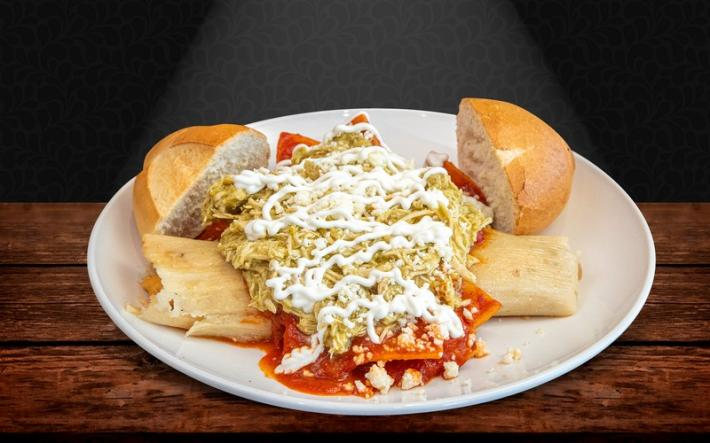
As a public service to the taco lifestyle, we have asked famed street gourmet Bill Esparza to drop some taco knowledge in this ground-breaking series we call TACOS 101.
Maize, corn, was first domesticated in Mesoamerica around 7000 years ago, some archaeologists date this as far back as 12,000 years. Around 1200-1500 B.C., nixtamalization was developed, the process of soaking and cooking the grain in lime water, and hulling it to prepare corn tortillas.
Tacos are a pre-hispanic food consisting of a tortilla, corn or flour*, folded in half, but sometimes rolled, filled with vegetables, meats, fish and seafood, insects, even just plain salt. The fillings are cooked using a variety of methods. While tacos were observed by Hernan Cortes and his men when they entered what is now Mexico City in 1519, and the current forms of taco production were established throughout the 20th century, certainly, there has never been a better time to enjoy tacos than the present.
In Spanish, a taco means tack, to plug a hole. No doubt, a taco fills that hole in your belly when you’re on the go, whether off to work, grabbing a quick lunch, shopping with the family, or just a little recharge after leaving the club.
The taco genre is ever expanding in its vocabulary, it seems as though a new style is unveiled each day. In general, the north is dominated by grilled meats, the south by stews of vegetables and meats, and in the coastal regions, tacos are filled with seafood. But, Mexico has 32 distinct regional styles of cooking, thirty-one states plus the capitol, Mexico City, and the taco varieties reflect this hyper-regionalism in a striking manner.
In Los Angeles, tacos are everywhere, and the City of Angels even has its own style of Mexican-American tacos, and burritos, which are a part of the taco family. In recent years, the Kogi Korean-Mexican fusion truck launched a taco frenzy of non-latino loncheros trying to cash in on this wave.
The big difference between tacos in Los Angeles and those in Mexico are in economics, traditions, culture, equipment, specialization, and formatting. The majority of the tacos in Los Angeles served from stands, taquerias, loncheros, and restaurants are poor to mediocre. The great ones are few, but some of those are as good as you’ll find from a competent location in Mexico.
Etiquette
In order to enjoy tacos, it would be valuable to understand taco etiquette. Ordering street food from a traditional taquero means calling out your order, this is a direct and masculine cultural practice. You may be waiting a long time if you’re standing there waiting to get called on or to make eye contact, unless there is a formal line. Your order should be a demand, not a question. Do say, “Me da dos tacos!”(Give me 2 tacos) Or, “tres de asada.” (Three asada tacos) There is no “may I....? Or, “I would like....please.” That’s how we order in American culture, not in Mexican street food. Let them know if you want it crispy, or any other special instructions beforehand. If the taco is made contrary to your liking, it’s your fault, not the taquero’s. The responsibility lies on you to get your al pastor griddled, for crispiness, or smooth, sliced directly from the spit into the tortilla.
Traditional taqueros have you pay at the end and go on the honor system. You let the money handler know how many tacos, other items, and drinks you had at the end of your meal, and he will add up your bill. Many here in LA now charge up front adapting to the American style of service.
Tacos are served in Mexico from stands, carts, stalls, fondas, and taquerias, here in Los Angeles, we also have the loncheros, or food trucks. Tacos should come from an eatery that can deliver tacos instantly. Avoid ordering tacos at a place where they will be sitting out on a counter waiting for a waiter, as tacos peak rather quickly. Tacos to go just aren’t the same experience as being handed a warm tortilla filled with sizzling meat.







